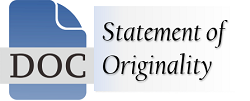Penentu Profitabilitas Bank Syariah: Kajian Nisbah Bagi Hasil dan Murabahah
DOI:
https://doi.org/10.31599/mrjbrp98Keywords:
Murabahah, Profit Sharing, Profit Margins, ProfitabilityAbstract
The purpose of this research is to analyze how the profit sharing ratio and profit margin in murabaha can affect the return on assets of Islamic banks in Indonesia. The method used in this research is quantitative descriptive, the data used is secondary data by taking data from Islamic bank financial reports for the period 2019 – 2021. The population of Islamic banks is 14 banks, then data is taken from 3 banks using a purposive sampling technique. In this study it was found that profit sharing ratios and profit margins in murabahah transactions are important in increasing the profitability of Islamic banks in Indonesia. High profit sharing for Islamic banks will increase bank profits, but profitable profit sharing ratios for Islamic banks will make customers reluctant to deposit their funds in Islamic banks which will reduce profits. Thus the size of the profit sharing ratio between the customer and the bank must comply with the principles of fairness and equity. Likewise, high profit margins charged to customers will make customers look for other financing alternatives outside of Islamic banks
Downloads
References
Anam, M. K., & Khairunisah, I. F. (2019). Pengaruh Pembiayaan Bagi Hasil dan Financing to Deposit Ratio terhadap Profitabilitas Bank Syariah Mandiri. Jurnal of Islamic Economics, Finance and Banking, I(2), 99–118.
Aprilia, S., & Mahardika, D. P. K. (2019). Faktor Yang Mempengaruhi Pembiayaan Bagi Hasil Pada Bank Umum Syariah Di Indonesia. Jurnal Riset Akuntansi Kontemporer, 11(1), 9–15. https://doi.org/10.23969/jrak.v11i1.668
Beureukat, B. (2019). Pengaruh Profitabilitas Terhadap Nilai Perusahaan Dengan Corporate Social Responsibility Sebagai Variabel Moderating Pada Perusahaan Pertambangan Yang Terdaftar Di Bursa Efek Indonesia. Oikonomia: Jurnal Manajemen, 14(1), 31–45. https://doi.org/10.47313/oikonomia.v14i1.512
Damanik, D., Panjaitan, P. D., Pardede, A. F., Muhammadin, A., Weya, I., Basmar, E., & Nasruddin, W. (2021). Sistem Ekonomi Indonesia. Yayasan Kita Menulis.
Effendi, S., Islam, U., & Utara, S. (2019). Perbandingan Sistem Ekonomi Islam Dengan. Jurnal Riset Akuntansi Multiparadigma, 6(2), 147–158.
Fathimah, V. (2017). Pengaruh Perkembangan Jumlah Tabungan, Deposito dan Bagi Hasil terhadap Jumlah Pembiayaan yang Diberikan oleh Perbankan Syariah di Sumatera Utara. Jurnal Ilman, 5(1), 41–52. http://journals.synthesispublication.org/index.php/ilman
Fitriana, E., Hanum, A. N., & Alwiyah. (2018). Faktor –Faktor yang Berpengaruh Terhadap Pertumbuhan Laba (Studi Empiris pada Perusahaan Manufaktur Sektor Industri Barang Konsumsi yang Terdaftar di Bursa Efek Indonesia Periode 2014-2017). Prosiding Seminar Nasional Mahasiswa Unimus, 1, 425–431.
Garwautama Sulaeman; Noor, Iqbal, P. K. S. (2021). Pengaruh Pembiayaan Murabahah, Pembiayaan Musyarakah, Pembiayaan Qardh Terhadap Profitabilitas. Balance : Jurnal Akuntansi Dan Bisnis, 6(2), 145–156. https://jurnal.um-palembang.ac.id/balance/article/view/3873/2578
Gujarati, D. N., & Porter, D. C. (2010). Essentials of Econometrics. New York, McGraw-Hill Companies, Inc,.
Hartono, R. (2019). Konsep dan Perhitungan Bagi Hasil pada penghimpunan Dana (Funding) di Bank Syariah. Asy Syar’iyyah: Jurnal Imu Syariah Dan Perbankan Islam, 4(1), 1–22.
Hasibuan, F. U. (2019). Analisis Pengaruh Pembiayaan Murabahah, Mudharabah, dan Musyarakah Terhadap Return On Asset Studi Kasus Pada PT Bank Muamalah Indonesia TBK. Periode 2015-2018. HUMAN FALAH: Jurnal Ekonomi Dan Bisnis Islam, HUMAN FALAH: Jurnal Ekonomi dan Bisnis Islam | Vol. 6 | No. 1 | 2019. http://jurnal.uinsu.ac.id/index.php/humanfalah/article/view/4162/2310
Jiang, H., Qian, J., & Sun, Y. (2020). Best linear unbiased predictors and estimators under a pair of constrained seemingly unrelated regression models. Statistics & Probability Letters, 158, 108669.
Jimoh, A. T., Attah, J. A., Nafiu, A. I., Polytechnic, F., & State, K. (2021). Murabaha-Related Credit Risk and Financial Performance of Islamic Banks in Africa. International Journal of Islamic Banking and Finance Research, 5(1), 60–69. https://doi.org/10.46281/ijibfr.v5i1.1279
Muthmainnah, K., Purnomo, J. H., & Hidayati, N. N. (2020). Mekanisme Bagi Hasil Simpanan Berjangka Syariah (Si Jaka) Di BMT Nurul Ummah Ngasem Jawa Timur. Jurnal Qawanin, 4(1), 40–70.
Nurjaman, K., Mustajam, A., Syaifuddin, S., Lubis, Y., & Abadi, Y. (2020). Meningkatkan Kinerja Perusahaan Dengan Menerapkan Konsep Manajemen Sumber Daya Manusia Strategik Dalam Menyongsong Persaingan Global. Komitmen: Jurnal Ilmiah Manajemen, 1(2), 73–82. https://doi.org/10.15575/jim.v1i2.10403
Otoritas Jasa Keuangan. (2021). Laporan Publikasi Keuangan.
Pramesti, I. (2020). Analisis Rasio Keuangan dalam Memprediksi Pertumbuhan Laba PT Astra International Tbk Periode 2014-2018. Jurnal Doktor Manajemen (JDM), 3(1), 98. https://doi.org/10.22441/jdm.v3i1.10146
Putri, R. D. (2020). Pengaruh Pembiayaan Murabahah Dan Musyarakah Terhadap Profitabilitas Bank Umum Syariah Periode 2016-2018. Jurnal Tabarru’: Islamic Banking and Finance, 3(1), 48–56. https://doi.org/10.25299/jtb.2020.vol3(1).5310
Setyawati, I. (2017). Did the Bank with Bigger of Total Assets had Ensured Its Financial Soundness ? Theory of Profitability. Iciebp, 169–175.
Setyawati, I., Kartini, D., Rachman, S., & Febrian, E. (2015). Assessing the Islamic Banking Financial Performance in Indonesia. International Journal of Education and Research, 3(10), 233–248.
Setyawati, I., Karyatun, S., & Awaludin, D. T. (2022). Stability And Resilience of Islamic Banking System: A Closer Look at The Macroeconomic Effects. Quality - Access to Success, 23(187), 295–304. https://doi.org/10.47750/qas/23.187.36
Setyawati, I., Suroso, S., Rambe, D., & Susanti, Y. (2017). Peningkatan Kinerja Keuangan Melalui Manajemen Kesehatan Pada Bank Syariah Di Indonesia. 1(2), 149–161.
Siagian, V., Rahmadana, M. F., Basmar, E., Purba, P. B., Nainggolan, L. E., Nugraha, N. A., & Purba, B. (2020). Ekonomi dan Bisnis Indonesia. Yayasan Kita Menulis.
Srivastava, V. K., & Giles, D. E. (2020). Seemingly unrelated regression equations models: Estimation and inference. CRC press.
Suretno, S. (2019). Instrumen Bunga dan bagi Hasil dalam Dunia Perbankan. Ad Deenar: Jurnal Ekonomi Dan Bisnis Islam, 3(2), 165. https://doi.org/10.30868/ad.v3i2.555
Usman, A., & Khan, M. K. (2012). Evaluating the Financial Performance of Islamic and Conventional Banks of Pakistan : A Comparative Analysis Abid Usman Sarhad University of Science & Information Technology. International Journal of Business and Social Science, 3(7), 253–257.
Widjaatmadja, D. A. R., & & Solihah, C. (2019). Akad Pembiayaan Murabahah di Bank Syariah dalam Bentuk Akta Otentik: implementasi rukun, syarat, dan prinsip syariah. Inteligensia Media.











_-_Copy1.jpg)




